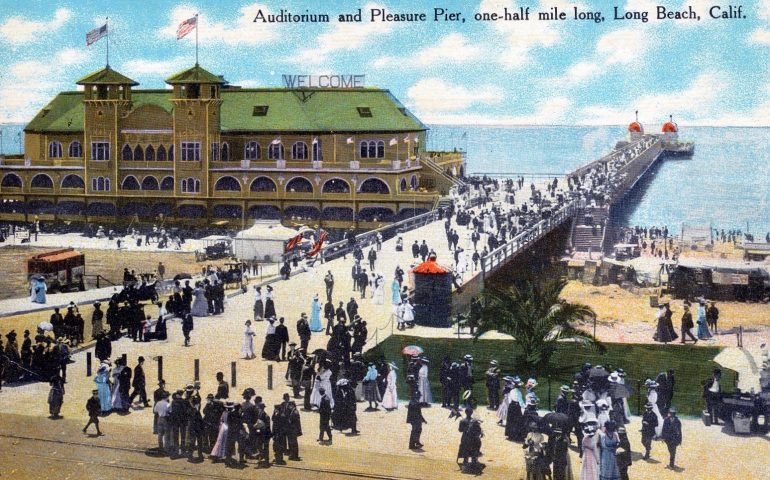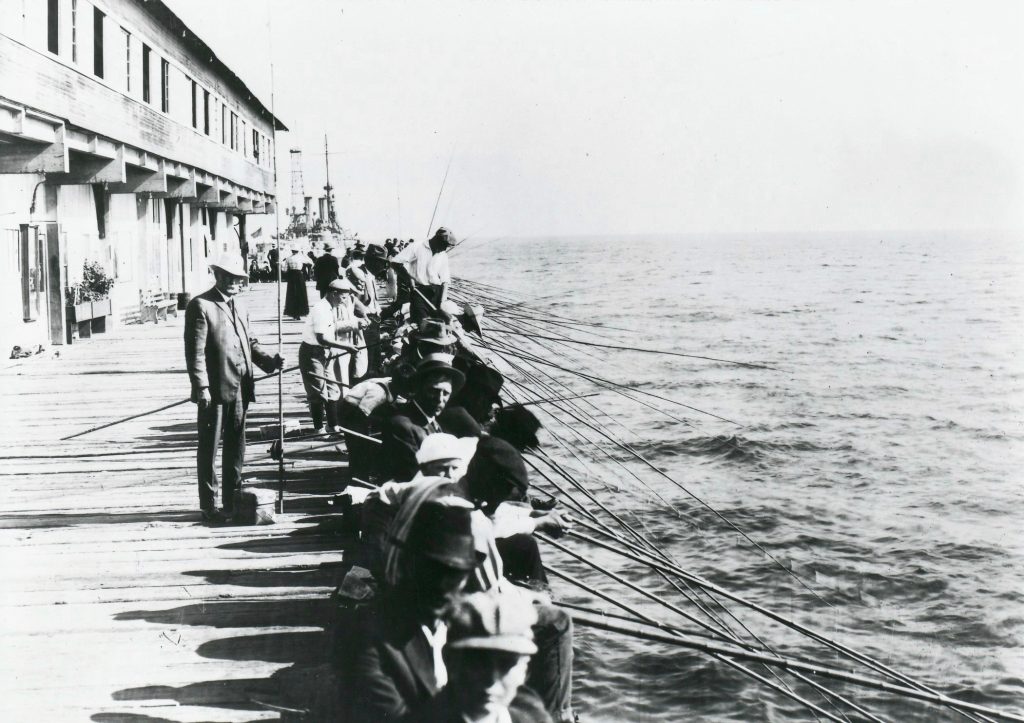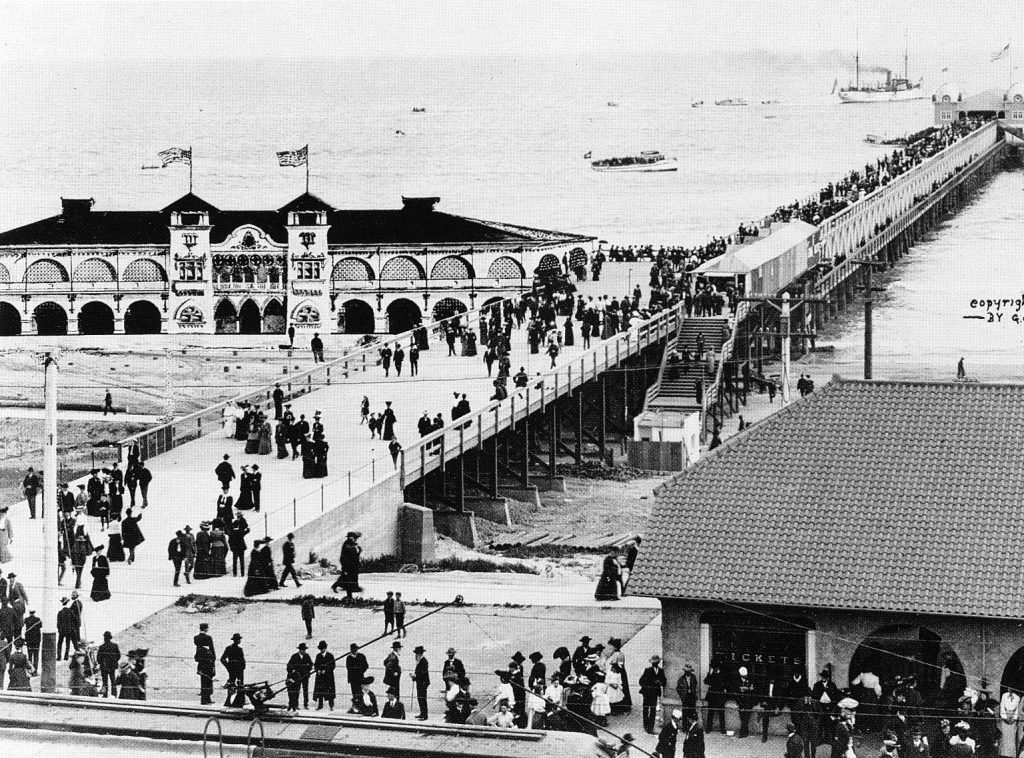As the first Pine Avenue Pier neared its end, it was clear that Long Beach, a now popular seaside resort and quickly growing town, would need a new pier. A committee was formed to look at the latest methods of construction. It proposed a structure with two decks at a cost of $100,000 and in November 1903 voters approved a bond issue for a new pier. Ironically, the 40-year bonds would not be paid off until 1943, almost a decade after the pier had seen its end.
One year later, in 1904, a new steel and concrete, 1,800-foot-long, double-decked pier was built. Piles made of expanded metal were driven into place in groups of three and encased in concrete. On shore, a beautiful pavilion was built and from the street to the pavilion the pier’s width was forty feet. The next 1,000 feet saw a width of thirty-two feet, and the final 300 feet of the pier saw a 100-foot width. At the end, the pier sat in water thirty-two feet deep (with the lower deck about 12 feet 8 inches above the high tide level).
However, on September 5, 1904, before the initial construction was even completed, a huge storm arrived. Waves 20 feet high attacked the new pier and caused an estimated $6,000 in damages. The storm may have been a harbinger of things to come but the pier had withstood the assault
The pier, called at various times the Long Beach Municipal Pier, the New Pine Avenue Pier, and the Long Beach Pleasure Pier, promised to be fun. A promenade for pleasure seekers as well as landing places for ships and pleasure craft were planned, the famous Sun Parlor was constructed out at the end of the pier, and early pictures show anglers jamming the lower level rails with their long bamboo poles. The city directory proudly proclaimed, “The main interest for the tourist and visitor is the opportunity it affords for an unrivaled marine promenade above the roaring breakers and out over the ocean billows for 1,800 feet.”
The pier was officially opened on November 12, 1904 with a “Pier Day” celebration with the usual festivities. California Governor George Pardee gave the main speech but was joined by Senator George Perkins, Congressman James McLachian, Mayor Eugene Lahee, the ex-Mayor Stephen Townsend, and dignitaries from Great Britain, Belgium, Mexico and Ecuador. Governor Pardee was presented the key to the gates of the pier by Miss Ella Wilson, Queen of the Sea, while the Navy gunboats Manning and McCulloch saluted the festivities. Yacht races and a huge barbeque followed. A table 1200-foot-long (of sorts) was constructed on the lower deck of the pavilion where 10,000 pounds of meat was barbequed to feed the expected “multitude.” Fireworks closed out the celebration.
Fishing quickly proved to be a favorite activity and day after day anglers with their “poles” would be lining the pier. Although the fish most common to the area were the normal catch, every so often something strange would show up.
Unknown Fish — A queer and unknown variety of fish was caught from the wharf by an Eastern tourist this morning. It was four feet long and weighed sixteen pounds. It had the body of a tuna and head of an albacore but along the back fin and tail is a thin yellow streak, while the lower fins are tipped with yellow. None of the local fishermen are able to identify it. —Los Angeles Times, December 31, 1904
A big run of five and six-pound albacore at Long Beach wharf kept the hand-liners busy at that point, and turned the outer end of the wharf into shambles, literally slippery with fish gore. These small albacore frequently come close inshore, but are of little use except upon the hook, like all the mackerel tribe they put up a tremendous fight, and give the man behind the rod a good time. —Los Angeles Times, February 28, 1905
Today it is illegal to save a lobster caught on a hook but it was much different back in the early days.
This Crawfish A Grand-Dad — Mammoth Redjacket Taken At Long Beach — Huge Specimen is Taken by Veteran Fisherman With Line Thrown From The Pier — Long Beach, July 7.—Frank Deffley, a veteran fisherman who has a stall under the wharf, while hauling in a line last night, thought for a few moments that he was pulling up the bed of the ocean, but when the hook reached near the surface of the water concluded that it was an octopus and began figuring how he could let go without cutting the line, for he had no desire for an encounter with a devil fish.
Fortunately it was not, but the monster is undoubtedly the patriarch and great-granddaddy of all the lobsters. It was safely landed and filled a tub made from a half barrel. From the tail to the head measures thirty inches, with a body twenty-four inches in circumference. The main feelers are each over eighteen inches in length and the feet, from which the claws are missing, over a foot long. Its weight is eighteen pounds and its age problematical, but the fishermen who observe lobsters at all, stages think it at least fifteen years old. The monster was presented to the aquarium where it is on exhibition. —Los Angeles Times, July 8, 1905
Over the years the municipal pier was to suffer the damage that is common to all piers. Almost as common is damage to building built on or attached to piers. In 1905, the almost new Pavilion at the shore end of the pier was destroyed by fire, which after the normal damage from waves and wind, was often the main cause of damage to the early piers. Later that year a new Municipal Auditorium was built on the same site, an auditorium that less than a decade later would be the scene of one of Long Beach’s greatest disasters.
The common name for giant sea bass in those days was jewfish, a name derogatory in nature. By the 1930’s, the name black sea bass was more commonly used but it too would be changed since black sea bass is a common East Coast fish. Today it is almost always simply called the giant sea bass.
Biggest Fish Of Season Caught At Long Beach — Long Beach, Dec. 25.—The biggest jewfish of the season, weighing 255 pounds, was hooked off the pier here today and, according to the lucky angler, Rochester Sandusky, who recently came to this city from Rilola, Ill., it was the first fish he ever caught. A great crowd was on the outer wharf at the time the big fish was caught and enjoyed immensely the spectacle it afforded in its mad efforts to get away. Ed Forest went out in a skiff and brought the creature to the landing. The fish was strung up in Will Graves’ fish market. It was six feet long. —Los Angeles Herald, December 26, 1906
Although the pier was still fairly new, only two years old, serious defects were soon noted, defects that would plague the pier and need attention and costly repair over the years.
Cement Soft In The Pier — Long Beach, Feb. 7.—When the city’s $100,000 pier was constructed three years ago, ugly rumors floated about the municipality had been badly “jobbed” but no absolute proof was ever presented… As time passed, however, conditions developed which are hard to explain. A year ago soundings were taken, resulting in the discovery that the sand around the caissons had been washed away to a depth of six or eight feet, and soon after a storm swept away several of the fender pilings and three caissons. Investigation showed that some of the fender pilings had been driven, but a few feet.
The Trustees took prompt action, and the people voted $36,000 bonds for rep[airs, which included filling in of the bottom around the caissons with four feet of rock. As a temporary expedient the caissons were all braced and bound together with timbers and bands of steel, making the underpinnings of the wharf one solid piece of framework…
A new and more serious defect has arisen. Wharfinger Beattge keeps constant watch not only above the wharf, but under it. Yesterday he made the startling discovery that the woodwork around one of the casissons had rotted away, and that the cement within was dry, and at the tough disintegrated like so much chalk. He promptly notified the Board of Public Works and steps will be taken promptly to repair the damages.
The fault is attributed to imperfect work, and that the cement was not properly mixed. When the caissons were sunk complaint was made that the constructing company allowed too much water to remain in the bottom of the caissons, resulting in weakening the cement so it would not solidify, but dried out without any life in it. —Los Angeles Times, February 8, 1907
Stingaree or sting ray were the common names given to bat rays during this time. Bat rays, also given the nickname mud marlin, can reach nearly 200 pounds in size and put up a terrific fight.
Long Beach Fisherman Gets Record Stingaree — Long Beach, June 1.—William Crowder, a West Long Beach fisherman, today caught a record-breaking stingaree, weighing 110 pounds and measuring four and one-half feet across the back. The sting was five inches long. This monster goes ahead of the stingaree which was caught off the local pier Wednesday and which was hailed as the biggest of the season. That one weighed sixty pounds. —Los Angeles Herald, June 2, 1907
A great big Iowan and a shovelnose shark, the former fishing in the ocean for the first time and later making a desperate struggle to escape, entertained loungers on the pier today. The Iowan was joshed unmercifully until he was fighting mad, but landed his prize after it had hopelessly entangled twenty-five fish lines in its struggles. —Los Angeles Times, August 4, 1907
Sea trout? This was the common name for small white seabass in those days, although the name was also frequently applied to larger fish.
Long Beach, Sept. 21.— Nearly 100 sea trout were caught off the outer wharf today, causing unusual excitement among the Waltons lining the edge of the pier.—Los Angeles Herald, September 22, 1907
Accidents can also happen! In November 1907, a boat landing collapsed at the end of the pier that knocked six men into the water. In December they sued the city for the tidy sum of $5,516.50. Today a similar suit would probably be ten times that amount—at least.
Monster Jewfish Caught Near Long Beach Pier — Giant weighs 350 Pounds and Is Thought To Be the One Which Recently Towed Men to Sea — Long Beach, Jan. 13.—In the stomach of a 350-pound jewfish caught by Clarence Owen near the pier, there were found three lobsters, weighing respectively one pound, two and two and a half pounds. The lobsters had evidently been swallowed but a short time before. Their shells were not even cracked. In the mouth of the monster were found several hooks and it is thought possible it was this jewfish, and not a whale, which towed James Harvey and Frank Paschall three miles out to sea in their skiff a week ago, when they went to examine their setline. About twenty-five hooks were broken off their line. —Los Angeles Herald, January 14, 1908
The problem with the pier’s concrete caissons was highlighted by a new report in February 1908. It said after consultation and inspection by experts, that (1) the original specifications for the concrete were imperfect AND (2) that the contractors had not even followed those specifications. Many caissons were now cut away more than a half and three were entirely gone. It was estimated it would take $50,000 to keep the pier seaworthy. Several different plans would be proposed.
In 1908, when TV’s hadn’t been invented and movies were in their infancy, the arrival of a fleet of Navy boats, the Atlantic Fleet or Pacific Fleet, was a big occasion as seen in the following:
Gala Display To Be Made At Long Beach — Long Beach, April 8.—At the time of the visit of the Atlantic fleet in these waters the upper deck of the pleasure pier will present a beautiful scene. Across the upper deck will be stretched row after row of pennants and flags., while the arches of the lower deck will be sheathed in palm branches so effectually that none of the timbers will be visible. The incandescent lights on the lower deck will be encased in red Japanese lanterns. The bases of the telephone poles along Pine Avenue will also be sheathed in palm leaves and over the street hundreds of strings of pennants will flutter. A ton of red fire will be burned along the beach and bluff and an electric sign of welcome, with letters six feet high, will be erected on the sun parlor. —Los Angeles Herald, April 9, 1908


